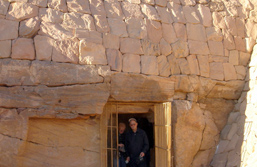Temple of Aniba
Aniba was regarded as the center of administration in Lower Nubia province of Egypt, in ancient times. In Egyptian language this place was called as Miam, while Lower Nubia was particularly known as Wawat in local language. During the rule of the Pharaoh Ramesses VI, he appointed Penniut as his Deputy for governing Wawat in 1140 B.C. Penniut was also known to be a priest of the local temple of Horus. Hence, his tomb was constructed in the local necropolis of Aniba on 12th century B.C. This rock-cut tomb was shifted to Amada in the 1960s, to save it from the waters of the Aswan High Dam, at the time of its construction. Its original site was located at the hillside of Aniba, that was 40 Km south of this present location. The original capital of Nubia, along with the official residence of Penniut was all destroyed by the flooding waters of the Aswan Dam.
The structural excellence of the Tomb of Aniba
This rock-cut tomb is noted for its simplicity in structure and extensive sculptures and inscriptions, throughout the walls of the tomb. It just contains an unadorned entrance, with the statues of Penniut and his wife in praying postures on the left side of it. This entrance leads to a transverse chamber, which housed three statues on a niche, in its backside wall, all of which are in almost destroyed state now. But the central figure has the head of a cow, which suggests that it might be of Goddess Hathor.
This chamber is 6.5 m wide and 2.8 m deep, which is comparatively much smaller than most of the Egyptian tombs, built in ancient period. The walls of the chamber contain the pictures of Penniut and his family members, offering tributes to the Egyptian gods. There are also the depictions of funerals and the final judgments, as per the beliefs of the ancient Egyptians. But unfortunately, a large section of these wall paintings and inscriptions are now missing, as they might have been cut off while shifting to Amada. On the right hand side of the chamber, the scenes on the wall showed the life of this living world; while the depictions on the wall of the left hand side are about the life after the death, including the judgments of the people in the next world.
The inscriptions on the walls of the Tomb of Aniba
The walls of the Tomb of Aniba are more important to the scholars for the inscriptions, which were most likely to be copied from the ancient Egyptian documents, written on papyrus. The main synopsis of one inscription states about a donation made by Penniut for making a statue of the Pharaoh. This particular inscription contains twenty lines and was written on the walls beside the entrance of the tomb, in a rectangular area. There are pictures of gods surrounding the upper part of this inscription, probably to indicate that the gods approved this donation. There are also prayers of offerings for each of these gods, written below their respective pictures. The pictures of Amun, Mut and Khonsu were drawn on the right hand of the inscription, while the images of Ptah and Thoth were sketched on the left side. All three walls of the chamber also contain inscriptions, which described offering methods and prayers to different gods.












0 comments:
Post a Comment